Advantage Multi for Dogs
Everything about Advantage Multi

What is Advantage Multi for Dogs?
Advantage Multi is also available as a product for cats but the two are not interchangeable. The information on this page relates canine use only.
Advantage Multi protects dogs against

Fleas

Heartworm

Worms

Mites
5 different weight ranges
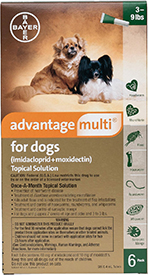 |
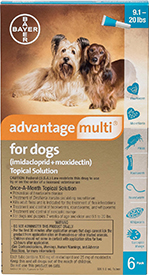 |
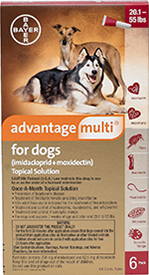 |
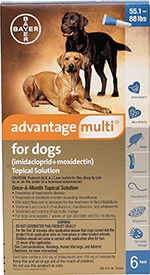 |
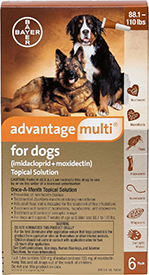 |
|
|---|---|---|---|---|---|
| Dog Weight (lbs) | 3-9 | 9-20 | 20-55 | 55-88 | 88-110 |
| Dog Weight (kg) | 1.5-4 | 4-10 | 10-24 | 25-40 | 40-50 |
| Tube size (ml) | 0.4 | 1 | 2.5 | 4 | 5 |
| Imidacloprid (mg/tube) | 40 | 100 | 250 | 400 | 500 |
| Moxidectin (mg/tube) | 10 | 25 | 62.5 | 100 | 125 |
Active ingredients
Imidacloprid
Imidacloprid is an insecticide that is classed as an ectoparasiticide, meaning it is used to treat external parasites. In the case of Advantage Multi for Dogs, Imidacloprid is used for the treatment of fleas in dogs. Imidacloprid works by affecting the central nervous system of both larval stage and adult fleas, leading to paralysis and ultimate death.
The use of Imidacloprid in Advantage Multi has been approved by the European Medicines Agency (EMA) and the US Food & Drug Administration (FDA). When used as directed, Imidacloprid has been shown to kill more than 98% of existing fleas within 12 hours of treatment.
Moxidectin
Moxidectin is a broad-spectrum insecticide that treats both internal and external parasites – an endoparasiticide and ectoparasiticide. In the case of Advantage Multi for dogs, Moxidectin is used to prevent heartworm in dogs, as well as treat hookworm, roundworm, whipworm and sarcoptic mites. Moxidectin cannot be used for the treatment of existing heartworm in dogs, but instead it eliminates the heartworm microfilariae before they can develop into mature heartworms.
The use of Moxidectin in Advantage Multi for dogs has been approved by the European Medicines Agency (EMA) and the US Food & Drug Administration (FDA). When used as directed, Moxidectin has been shown to be 100% effective in preventing the development of heartworm.
Product administration
For the prevention of heartworm, Advantage Multi for dogs needs to be administered at one-month intervals, all year round. When starting treatment, the first dose should be administered one month before the first expected exposure to mosquitoes. For the elimination of existing heartworm microfilariae in heartworm-positive dogs, the treatment should be administered at one-month intervals.
For the treatment of fleas, Advantage Multi for Dogs will kill any existing adult fleas on the dog. However, as eggs in the environment will continue to hatch and reinfest the dog, several monthly treatments may be needed to break the breeding cycle.
For the treatment of intestinal worms and sarcoptic mites, Advantage Multi for dogs can be applied as a single topical dose. In the case of sarcoptic mites, a second monthly dose may be needed.
Advantage Multi vs Other Brands
 |
 |
 |
 |
 |
|
|---|---|---|---|---|---|
| Type of Application | Topical | Topical | Tablet | Topical | Chewable |
| Fleas | ✔️ | ✔️ | ✔️ | ✔️ | |
| Heartworm | ✔️ | ✔️ | ✔️ | ✔️ | |
| Roundworms | ✔️ | ✔️ | ✔️ | ||
| Hookworms | ✔️ | ✔️ | ✔️ | ||
| Whipworms | ✔️ | ✔️ | |||
| Safe for Pregnant or Nursing Pets | ✔️ | ✔️ | ✔️ | ||
| Active Ingredient(s) | Imidacloprid, Moxidectin | Imidacloprid, Pyriproxyfen | Milbemycin Oxime, Lufenuron | Spinosad, Milbemycin Oxime | Ivermectin, Pyrantel Pamoate |
| Dosage | Monthly | Monthly | Monthly | Monthly | Monthly |
Parasites
Heartworm
(Dirofilaria immitis)

Heartworms are a fairly prevalent yet very problematic parasite that can affect dogs of all ages, breeds and lifestyles. From a single mosquito bite, dogs can develop heartworm disease, which is often deadly if not treated early, and even with treatment can be very damaging to your dog’s health.
Heartworms were first discovered in coastal parts of the southern United States in the mid-1800s, and for many years were restricted to this area. Since then they have spread right throughout the country and most continents, with reported cases in Europe, South America, South East Asia, Australia, the Middle East, Korea and Japan.
A dog can only be infected with heartworm through the bite of an infected mosquito. So while heartworm is considered worldwide problem, there is greater risk in areas with more mosquitos, namely temperate and tropical climates. Heartworm not only affects dogs, but a number of other mammals including cats, foxes, wolves and coyotes, so an increased risk is found wherever there are more of these animals.
Once a dog is infected with heartworm larvae through the bite of the mosquito, the larvae develop into adults and begin to cause damage to the heart, lungs and arteries. This is what is referred to as heartworm disease. Unless treated, these adult heartworms will continue to grow and reproduce, causing often fatal damage to the organs.
Fleas
(Ctenocephalides felis, Ctenocephalides canis)

Most owners will dread that tell-tale itch that is one of the most obvious signs that their dog has fleas – these irritating parasites are unfortunately one of the dangers of owning a dog. They are highly common worldwide among mammals and even birds due to the fact they can be easily spread and have a fast and effective breeding cycle.
Fleas live on the body of the host, such as your dog, where they bite and feed on the animal’s blood. After reproducing, the eggs fall to the ground where they develop into larvae in the environment. This makes flea infestations very hard to control, as it is not only the host animal that needs to be treated. Although they can’t fly, fleas can jump great distances and can easily be transferred from one animal to another.
Flea borne diseases
As well as causing general irritation to your pup, fleas can cause more serious issues than just their bites. Simply by feeding, fleas can cause a number of medical conditions, and they can also be vectors for disease.
Anaemia – this is not technically a disease, but rather a condition in which the animal has a lower than normal red blood cell count, in this case due to the blood loss that occurs during feeding. This isn’t usually an issue for adult dogs, but can affect puppies or small breeds of dogs who don’t have the blood supply to cope with the blood loss.
Symptoms of anaemia include:
- pale gums
- lethargy
- weight loss
- loss of appetite
- rapid pulse
Bartonellosis – also known as cat scratch disease, Bartonellosis is an infectious disease caused by the bacteria Bartonella. In dogs, the bacteria that cause the disease are usually transmitted by ticks, but can also be spread by flea bites. Despite the name, the disease is rarely passed through the scratch of a cat, though dogs can transmit the disease to humans through biting.
Symptoms of Bartonellosis in dogs include:
- a red bump at the site of the bite
- loss of appetite
- lethargy
- vomiting
- fever
- diarrhea
- enlargement of the spleen and liver (acute cases)
- inflammation of the heart, lymph nodes and brain (acute cases)
Flea allergy dermatitis – while all dogs will be irritated by the bite of a flea, some dogs may develop an extreme reaction to flea bites that will cause them to itch for weeks after the initial bite. This is known as flea allergy dermatitis (FAD) and occurs when the dog has an allergic reaction to a particular protein that is found in flea saliva, which is injected as they bite.
Symptoms of flea allergy dermatitis in dogs include:
- intense scratching or biting, particularly around the hind quarters
- hair loss
- raw or scabbed skin
- small, raised bumps on the skin
- secondary skin infections
Tapeworm – this is not a disease in itself but in fact another parasite that is transmitted by fleas. Tapeworm eggs are ingested by fleas as they feed on an infected animal. The eggs then develop within the flea, becoming infective larvae. During the course of their grooming, in response to a flea bite or by eating an animal such as a mouse, your dog may ingest a flea and the tapeworm larvae along with it. Adult tapeworms inhabit your dog’s intestines, where they complete their lifecycle. Tapeworms are not usually dangerous for adult dogs but may cause problems for puppies, old dogs or sick dogs.
Symptoms of tapeworm in dogs include:
- scooting their hindquarters on the ground
- segments of tapeworm in the faeces
- abdominal discomfort and diarrhea (heavy infestations)
- weight loss (heavy infestations)
Hookworm
(Ancylostoma caninum, Uncinaria stenocephala, Ancylostoma braziliense)

There are several species of intestinal parasite affecting dogs that are given the name hookworm. The name refers to the hook-like mouth parts of the worm, which they use to attach to the lining of the small intestine. The hookworms live their adult lives in the digestive system, where they feed on the blood of the host. If left untreated, hookworms can cause serious issues for dogs and can even be fatal. Fortunately, hookworms can be easily treated with the use of a worming medication such as Advantage Multi.
Hookworms are a fairly common parasite worldwide, but each species tend to be more prevalent in particular areas. Ancylostoma braziliense is endemic within the United States, but also widespread in Central and South America, South Africa and some parts of Asia. Ancylostoma caninum is largely found in warmer climates and the species is mainly found in Southeast Asia, while Uncinaria stenocephala is the most common hookworm in cooler climates.
Symptoms
The symptoms relating to hookworm are largely related to the way the parasite feeds, which causes continued blood loss to the host. While a healthy adult dog may be able to withstand this feeding, puppies may need blood transfusion to survive the blood loss.
Symptom of hookworms in dogs include:
- anaemia
- pale gums
- weight loss
- failure to thrive (puppies)
- diarrhea
- dark, sticky stools
- lethargy
- red, itchy sores on the feet where hookworms have entered the skin
How hookworms are transmitted
One of the reasons that hookworms are so prevalent is that transmission can occur even before a dog is born. Mothers that have hookworm can pass the parasite to their puppies in utero, through the placenta. It’s also possible for the hookworm larvae to be passed through the mother’s milk as the puppies feed.
In the case of adult dogs, there are a number of methods of transmission. One is by licking or even sniffing soil or faeces that contains hookworm larvae. The other is by walking on soil that contains the larvae, which burrow directly through the dog’s skin and enter the body. Hookworm larvae may lie dormant in the environment for weeks or even months waiting for a new host, so even when there has been no recent infestation in an area, there is still a risk of picking up the parasite.
Hookworms in humans
Roundworm
(Toxocara canis, Toxascaris leonine)

Nearly every dog will be affected by roundworms at some point in their lives. This intestinal parasite is found in most parts of the world and many puppies are even born with them. Despite being very common, roundworms are also very easily treated.
Roundworms are white, cream or brown in colour and can grow up to 10-12 cm long. They take up residence in the dog’s intestinal tract, where they eat partially digested food, often depriving the host of vital nutrients. Unlike hookworms of some other intestinal parasites, they do not attach themselves directly to the intestinal wall, but rather swim freely.
Symptoms
The symptoms displayed will depend on the infected dog’s age, health and the number of roundworms present. It is quite common for a healthy, adult dog to be infected with a small number of roundworms and not show any symptoms at all. However, the dog’s owner may notice expelled worms or partial worms in the dog’s faeces or vomit.
Symptoms of roundworms in dogs include:
- abdominal swelling
- vomiting
- diarrhea
- weight loss
- lethargy
- dull coat
How roundworms are transmitted
As with hookworms, roundworms may be transmitted to puppies before they are born, as the infected mother passes the larvae through the umbilical cord. If the parasite is not transmitted this way, it can also be passed through the mother’s milk once the puppies are born.
Roundworms can also be contracted through the environment, which is the most common form of transmission for adult dogs. After the roundworm eggs are passed out of the host’s body, the faeces decompose and the eggs are released into the soil. Dogs licking or sniffing at this soil then ingest the eggs, becoming infected with the roundworm. Alternatively, a dog walking on contaminated soil may later groom themselves and the contaminated soil is ingested in this way.
Another method of transmission is via a secondary host. If a small animal such as a mouse, bird, cockroach or worm eats this soil, they pick up the roundworm eggs. If you dog eats one of these contaminated animals, the eggs pass into their intestines and begin the next stage of their lifecycle.
Roundworms in humans
Roundworms can have serious implications, especially for young children or pregnant women. If untreated they can cause damage to the eyes, lungs or heart and in some cases may cause neurological issues.
Whipworm
(Trichuris vulpis)

Named for their whip-like shape, which is thin at one end and thicker at the other, whipworms are one of the four most common intestinal worms found in dogs. Whipworms attach themselves to the wall of the large intestine, where they feed on the blood of their host.
Whipworms have a high distribution worldwide and are commonly found in household pets and sheltered dogs. In the USA, infection rates in kennels may be up to 30%, and the infection rate in stray dogs in other countries may be as high as 60%.
Symptoms
Dogs with only mild cases of whipworm might not show any signs at all, but more severe infections can cause serious problems and may even lead to death if left untreated.
Symptoms of whipworms in dogs include:
- anaemia
- weight loss
- dehydration
- diarrhea
- mucus or blood in the stool
How whipworms are transmitted
As with many other intestinal parasites, whipworm eggs are laid within the digestive system and are passed out of the host’s body via the faeces. The eggs then pass into the soil, where they are picked up by dogs either sniffing or licking the contaminated soil. Whipworm eggs have an incredibly hard shell that allows them to survive in the environment for up to seven years, even withstanding freezing temperatures or extreme heat.
Unlike hookworms or roundworms, whipworms cannot be passed from mother to pup when in utero or when nursing.
Whipworms in humans
Sarcoptic mites
(Sarcoptes scabiei var. canis)

These microscopic parasites are a very common problem among dogs, affecting animals of all ages and breeds in both tropical and cooler climates. These mites are highly contagious, spreading from dog to dog via direct contact. Once on the host they burrow under the skin where they cause intense irritation. Sarcoptic mites, also known as mange mites, are too small to be seen by the human eye, and their presence will need to be confirmed by a veterinarian.
Sarcoptic mites can be transmitted form dogs to humans, where they will cause intense itching. However, the mites cannot complete their breeding cycle on humans, so there will be no continuation of the infestation once the mites die.
Sarcoptic mange
Sarcoptic mange or scabies is the name given to an infestation of sarcoptic mites and the skin condition that it causes. Once the mites burrow beneath the skin they cause incredible itching to the host. As the dogs is constantly scratching, this leads to damaged skin, inflammation and infections.
Symptoms of sarcoptic mange in dogs include:
- constant scratching
- red, inflamed skin
- hair loss – particularly around the legs and stomach
- self-mutilation
- thickening of the skin due to damage
- secondary infections in open sores
Heartworm disease
How heartworms are transmitted
Stages and symptoms of heartworm disease
Unlike other parasites, heartworms cannot easily be eliminated once they have reached a certain stage of development within the body. This is why it is so important for owners to recognise and understand the different stages of the disease.
The initial stage of a heartworm infection is when the heartworms have entered your dog’s body. At this point the heartworms are still at the larval stage of development and may still be eliminated by the use of a heartworm preventative such as Advantage Multi. Dogs will not yet be displaying any signs of infection or disease.
The disease becomes problematic as the heartworm larvae make their way through their body and develop into adults. As they reproduce in the heart and lungs, they begin to cause issues for your dog’s health. Dogs that have this level of infection may show signs such as a minor cough or less interest in exercising than usual. Heartworms that have developed to this stage are now detectable via a blood test, but can no longer be treated with a regular heartworm preventative.
Without intervention, the adult heartworms will continue to grow and reproduce within the dog’s body, increasing the damage. Dogs will now begin to show obvious signs of disease and may be in some distress. The heartworms themselves will be large enough to be detected using an x-ray.
Your dog may display signs such as:
- persistent cough, often with bleeding
- lethargy or lack of interest in exercise
- weight loss
- breathing difficulties
- bulging ribs
As the disease develops further, the symptoms may remain the same but the implications become much more serious. At this point, even if the heartworms are successfully eliminated from the body, the damage that they have caused to the internal organs often remains. Even with treatment, dogs that have reached this stage of the disease often do not recover.
Heartworm treatment and prognosis
Though there is heartworm treatment available for dogs, it can be a very costly and traumatic process and does not always succeed, which is why heartworm preventatives are so important.
The first stage of the process will be a simple blood test to determine the presence of heartworm in your dog. This test is sophisticated enough to detect the presence of a single adult female within the host. If this test is positive, your vet will then conduct a further series of tests which will help him or her determine how many heartworms are in the body and how the disease has developed. These tests may include x-rays or radiographs that will reveal any enlargement of the heart or obstructions to the arteries, or ultrasounds to check the integrity of the heart, lungs and liver.
The next stage of the treatment will depend on the results of these tests, and whether your dog has any problems that need immediate attention. Dogs that are experiencing breathing problems may be administered diuretics to remove fluid that has built up in the lungs, and may even need to be hospitalised until they can breathe normally. Other medications administered at this stage may include painkillers, drugs to improve heart function or antibiotics to treat bacteria that often live alongside the heartworm.
If tested positive for heartworm disease, your dog will need to be somewhat restricted in its movements, as exercise increases the rate at which heartworms cause damage to the heart and lungs. Milder cases may simply be required to give up exercise, while in more serious cases, your dog will need to be crated during the course of the treatment to prevent as much movement as possible.
It is not until around 60 days after initial diagnosis that the actual treatment for heartworm disease can be started. The treatment to remove the adult heartworms involves a course of adulticide injections that must be administered by a vet. This is initially two injections that are given 24 hours apart. Your dog may be required to stay overnight following the first injection, so that they can be monitored for any adverse reactions to the medication. The vet may administer a course of steroids to counteract any inflammation that develops at this point.
A second round of injections will be required one month after the first, again as two injections spaced 24 hours apart. One month following these second injections, your vet will perform a series of tests to check the progress of the disease and the effectiveness of the treatment.
Your dog will need to remain restricted in its movement during this time, even if the treatment is proving effective and they do not have any serious complications. As the injections kill off the adult heartworms, their bodies float into the vessels that send blood to the lungs. Any excessive movement by your dog increases the chances that the bodies of the heartworms will end up blocking the blood flow, which could cause a number of complications, including death.
Six months after the first set of injections (eight months after the initial diagnosis), you vet will perform a final test to ensure that all the adult heartworms have been successfully eliminated. From the first stages of treatment, your dog will need to be on a strict monthly dose of heartworm preventative to make sure that no new infections develop during this time.
Parasite lifecycles
Heartworm

Microfilariae
Infective larvae
Juvenile adults
Adults
Eggs
The flea starts its life as an egg, which are laid by the adult female in the dog’s fur, usually around 20 at a time and up to around 40 per day. Many of these eggs fall from the dog, ending up in the environment such as carpet or bedding.
Larvae
Pupae
Adults
Eggs
The adult female worm lays her eggs within the digestive system of the dog, after which they are passed out via the faeces. At this point they are not infective, but develop over the course of 2 days to 2 weeks, depending on the species of worm.
Larvae
Adult
Eggs
Once an adult female scabies mite infests a new host, she burrows under the skin and begins to lay eggs, usually around 2 to 3 per day. She does this over a period of 2 to 3 weeks, with the eggs hatching in around 3 days.
Larvae
Nymph
Adult
Side effects
The reported side effects after treatment with Advantage Multi have shown to be different between heartworm-negative dogs and heartworm-positive dogs.
In heartworm-negative dogs treated with Advantage Multi, owners reported the following adverse reactions: pruritis (itching skin), lethargy, loss of appetite or hyperactivity. In heartworm-positive dogs, adverse reactions include coughing, lethargy, vomiting, diarrhea, loss of appetite, shortness of breath or rapid breathing.
The application of Advantage Multi for dogs may also cause hair loss around the site of application. This is a temporary condition and will resolve without treatment.
Ingestion of the product may cause more serious symptoms such as dilation of the pupils, depression, salivation, loss of coordination, panting and muscle tremors. Ingestion often occurs when dogs are able to lick the site of application or if they lick another dog who has been recently treated.
Precautions
Anyone handling or applying Advantage Multi should take the following precautions:
- Do not administer this product orally
- Do not administer to cats
- Do not apply to irritated skin
- Prior to application, dogs should be tested for existing heartworm
- Do not stroke or groom your dog until the application site is dry
- Recently treated animals should not be allowed to groom each other
- Treated dogs should not come into contact with untreated animals until the site of application is dry
- Care should be taken to ensure your dog does not lick the application sites
- Advantage Multi is harmful to aquatic organisms and treated dogs should not be allowed to swim in waterways for 4 days after application
- Do not eat, drink or smoke during application
- Avoid contact with skin, eyes or mouth
- Wash hands well after handling
- Store at temperatures between 4°C (39°F) and 25°C (77°F)
Our review
Package contents

Inside the box is a blister pack that contains the individual pipettes. These are individually sealed and should only be removed immediately before application.
Application
Applying the product is relatively easy. With your dog in standing position, you need to part the hair at the back of the neck until you can see the skin. For smaller dogs (weighing less than 20 lbs), the entire contents of the tube should be applied in one spot. Slowly squeeze the tube to empty it, ensuring that none of the product drips away to a place where your dog could lick it.
For larger dogs (weighing more than 20 lbs), you will need to apply the product in 3-4 spots along the upper spine, starting from the base of the neck. Again, ensure that you do not apply too much liquid in any one spot or there could be a risk of dripping.
The product will dry in around 30 minutes, during which time you should avoid touching the area. The hair at the application site may appear stiff or damp or covered in a powdery residue, but this is only temporary.
Pros
- Protects against both internal and external parasites
- Provides month-long protection against heartworm
- Topical application means treatment can’t be refused
- Safe for use on puppies as young as 7 weeks
Cons
- Does not protect against ticks
- Cannot be used on pregnant, nursing or breeding dogs
- Dogs cannot swim or bathe immediately after treatment
FAQs
How long does Advantage Multi take to work on fleas and worms?
Can my dog be bathed or go swimming after applying Advantage Multi?
Is Advantage Multi safe for pregnant or nursing dogs?
Can I use Advantage Multi with worming tablets?
Where to buy
 |
 |
 |
|
|---|---|---|---|
| Score | ⭐⭐⭐⭐⭐ 5/5 |
⭐⭐⭐ 3/5 |
⭐⭐ 2/5 |
| Price of Advantage Multi | From $31.95 | From $51.95 | From $67.95 |
| Free worldwide shipping | ✔️ | ❌ | ❌ |
| Shipping time | 3-7 business days | 14-20 business days | 10-15 business days |
| Auto-delivery option | ✔️ | ✔️ | ✔️ |
| Accepts return | ✔️ | ✔️ | ✔️ |
| 24/7 support | ✔️ | ❌ | ❌ |
| Wide range of products | ✔️ | ✔️ | ✔️ |
| Loyalty program | ✔️ | ❌ | ✔️ |
| User-friendly storefront | ✔️ | ✔️ | ✔️ |
| Multilingual storefront | ✔️ | ❌ | ❌ |
| Customer reviews | 5/5 1301 reviews |
2.7/5 1192 reviews |
3.6/5 922 reviews |
| Shop Now | Shop Now | Shop Now |
User Reviews
Have you treated your dog with Advantage Multi? Let us know how the experience was!